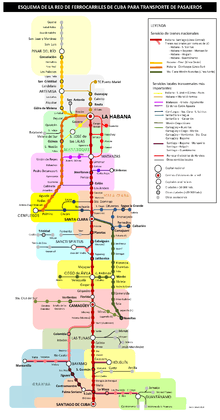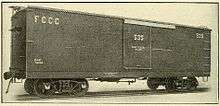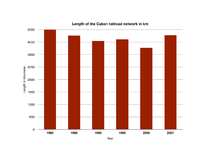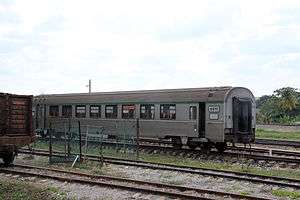Ferrocarriles de Cuba
|
Railway map of Cuba | |
| Reporting mark | FFC (also: FC, FFCC) |
|---|---|
| Locale | Cuba |
| Dates of operation | 1924– |
| Track gauge | 1,435 mm (4 ft 8 1⁄2 in) |
| Electrification | 140 km |
| Length | 4,226 km (2,626 mi) |
| Headquarters | Havana |

Ferrocarriles de Cuba (FCC) or Ferrocarriles Nacionales de Cuba (English: National Railway Company of Cuba), the only railway operating in the Caribbean islands, provides passenger and freight services for Cuba.
Route network
Ferrocarriles de Cuba uses 1,435 mm (4 ft 8 1⁄2 in) (standard gauge) that extends from Guane (province Pinar del Río) in the westernmost part of the island up to the bay of Guantánamo in the eastern part. The 835 km central railway runs from Havana to Santiago de Cuba in the eastern region. Most of the 4,226 km is diesel with 140 km electrified. The flagship Train Number 1 travels between Havana and Santiago de Cuba. Other long distance passenger services link Havana to Pinar del Río (western railway), Cienfuegos (South branch), Sancti Spiritus, Bayamo-Manzanillo and Guantanamo. The network connects the six first level ports in Cuba: Havana, Mariel, Matanzas, Cienfuegos, Nuevitas and Santiago de Cuba, as well as all province capital cities.
The Hershey Electric Railway is an electrified railway from Havana to Matanzas that was built by the Hershey Company in order to transport workers and products after it had bought sugar plantations in 1916. It is a commuter service running in northern Havana and Matanzas provinces using some original equipment.[1]
History
Colonial Cuba
In 1836 Gaspar Betancourt Cisneros established a horse-drawn railway service called Ferrocarril de Camagüey a Nuevitas in Camagüey (Puerto Príncipe).
Cuba's railway history began on October 12, 1834 when the regent queen of Spain Maria Christina of the Two Sicilies approved the building of the first line. When the Compania de Caminos de Hierro de La Habana opened the 27.5 km line from Havana to Bejucal on November 19, 1837, it was the first steam railway line in Latin America. At this point Spain did not possess any railroad lines. The 27.5 km long line from Havana was extended by an additional 17 km to Güines on 19 November 1839. By December 1843 the cities San Felipe and Batabanó were added to the rail network and further extensions were added in 1847 (17 km), 1848 (21 km), and 1849 (21 km).
Havana had its first streetcar (Ferrocarril Urbano de la Habana) when its service commenced on 3 February 1859.
Pre-Revolutionary Cuba

American-born Canadian railway builder Sir William Van Horne helped expand Cuba's railway network in the early 20th century. He was an investor in the Cuba Railroad Company (founded 1900).
In 1924 Ferrocarriles Consolidados de Cuba was created from a dispute between Ferrocarriles Consolidados de Cuba and Ferrocarriles de Cuba.
Other railway companies formed and merged in the 1920s:
- Ferrocarriles del Norte de Cuba 1916
- Ferrocarril Espirituano Tunas de Zaza
- Ferrocarril Guantánamo y Occidente
From 1940 to 1959 Cuba's railway system was modernized by the acquisition of train stock from Budd and Fiat. These trains provided medium speed self-propelled (diesel) four-car trains service on the main line between Havana and Santiago de Cuba. Also after World War II a large network of diesel intercity buses was created with four or five major carriers competing in the east-west corridor between Havana and the provinces to the east. After the revolution with the nationalization of the transportation system, the diversion of resources to defense expenditures and the lack of competition for the service, the train stock slowly deteriorated; this coupled with the inability to obtain replacement parts from the US that had been the main supplier of the equipment for decades destroyed the once efficient system.
A few sugar factories switched over to diesel electric locomotives to haul freight. By 1958, Cuba had more railway trackage per square mile than any other country.
Train ferry
- Prior to the revolution there was a train ferry between Miami and Havana.
- The West India Fruit and Steamship Company was one of a number of companies to provide such service.
Post-revolutionary Cuba

The destruction of President Fulgencio Batista's armoured train by the revolutionaries in the Battle of Santa Clara in December 1958 was an important stepping stone in the Cuban revolution.
After the revolution in 1959, the Ferrocarriles Nacionales de Cuba was created by nationalizing the private and public railway systems. MINAZ continued to operate a separate railway system, mainly to transport sugar products.
From 1963 to 1966, British Rail helped the national railway obtain newer locomotives which were based on the Brush Type 4 locomotives (later Class 47) at the time being built at Brush Traction in Loughborough, but the final assembly of the Cuban locomotives was performed at Clayton Equipment Company Hatton, Derbyshire.[2] After the Cuban Missile Crisis, it became harder for Cuba to buy new railway equipment because of the United States embargo against Cuba. Some trains were delivered via shipment with ships from third countries like the Socialist Federal Republic of Yugoslavia. For example, the British locomotive shipped from Hull using Yugoslavian ships.
Purchase of new trains and parts to Cuba with the Western Bloc, stopped from the late 1960s, was replaced through trade with the Eastern Bloc. This trade link collapsed with the fall of the Soviet Union.
Cuba was able to obtain used trains and new locomotives, from friendly nations not affected by the embargo:
- 5 Type RSC18 locomotives were shipped from Canada
- 9 electrical motor coaches from Ferrocarrils de la Generalitat de Catalunya (FGC) (Catalonian Government Railways) of Spain
Starting in 2000, the Cuban railway network was improved by more second hand equipment. More used vehicles were coming from Canada, Mexico and Europe. In 2002 used light rubbing cars (BR771) were acquired from Germany.
Much of Cuba's trains are diesel and only a handful of steam locomotives remain for the sugar industry and the tourism industries.
After the 1990s, China became the new supplier of railway cars for Cuba. In 2006, 12 new locomotives (Type DF7G-C at 2,500 hp or 1,900 kW) were shipped to Cuba. China Railways also sold some of its retired cars.
Recent developments
On September 25, 2007, investors from the Venezuelan Bank for Socio-Economic Development (BANDES) reached an agreement with transportation officials in Cuba to invest US$100 million for infrastructure improvements and repairs to Cuba's rail network. The work is expected to help increase the average speed of trains on Cuba's railways from 40 km/h (25 mph) to 100 km/h (62 mph). As part of the agreement, Cuban engineers will also work on similar projects on Venezuela's rail network.[3]
In October 2007, the Cuban railways ordered two hundred passenger cars and 550 freight wagons from Iranian manufacturer Wagon Pars.[4]
In May 2010, the Cuban government announced wide-ranging plans to repair the railway network, buy new rolling stock, and open four centres to train railway workers.[5]
Rolling stock
Freight cars were mainly acquired from former Eastern Bloc countries and the then USSR, whereas passenger cars from other countries friendly to Cuba (Spain, Japan, Canada and France).[10][11]
See also
- Camagüey railway station
- Havana Central railway station
- Havana Suburban Railway
- Santa Clara railway station
- Santiago de Cuba railway station
- Transportation in Cuba
References
- ↑ Morrison, Allen (2008). The Hershey Cuban Railway. Retrieved 2008-02-16.
- ↑ Ram, Thunderbuck. "Class47.co.uk ~ Cuba".
- ↑ "Cuba to Develop Railroad System with Venezuelan Assistance". Cuban News Agency (ACN). 2007-09-25. Retrieved 2007-09-25.
- ↑ "Iran to build 300 wagons for Cuba". Iran Khodro Industrial Group. 2007-10-30. Retrieved 2007-11-29.
- ↑ "Cuba to repair national network?". IRJ. 2010. Retrieved 2010-05-14.
- ↑ "Toll alles Muss Raus – tamr.org".
- ↑ "Statistik 771/ 772". 26 August 2009.
- ↑ http://www.27rail.com.cn/_mainpage/eindex1/eindex1.aspx
- 1 2 "http://www.railjournal.com/index.php/locomotives/cuban-railways-orders-75-locomotives-from-sinara.html". International Railway Journal. July 25, 2016. External link in
|title=(help) - ↑ "Cuba purchases Chinese diesel locomotives - Trains Magazine - Trains News Wire, Railroad News, Railroad Industry News, Web Cams, and Forms".
- ↑ "Train travel in Cuba - a beginner's guide".
- Zanetti Lecuona, OSCAR; García Álvarez, Alejandro: Caminos para el azúcar, La Habana: OD. de Ciencias Sociales, 1987.
- Zanetti Lecuona; García Álvarez: Sugar and Railroads. A Cuban History; 1837–1959, Chapel Hill & London: The University OF North Carolina press, 1998.
Further reading
- "Cuban 'Class 47' still in existence". RAIL. No. 327. EMAP Apex Publications. 25 March – 7 April 1998. p. 60. ISSN 0953-4563. OCLC 49953699.
External links
| Wikimedia Commons has media related to Rail transport in Cuba. |
- Full bus and train timetable
- Ferrocarriles de Cuba information — with time tables.
- Hershey Electric Railroad in Cuba


